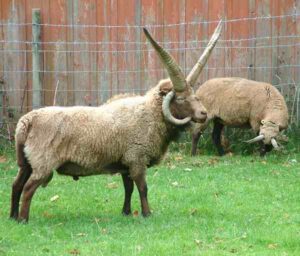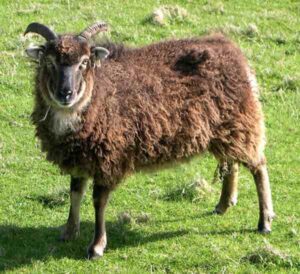The Katahdin sheep is a breed of domestic sheep from United States. It was developed in Maine, United States and named after Mount Katahdin (the highest peak in Maine).
It was developed by Michael Piel during the second half of the 20th century. Michael Piel imported selected St. Croix sheep, chosen by Dr. Richard Marshall Bond (Director of the Virgin Islands branch of the U.S.D.A), and crossed them with various other sheep breeds including the Suffolk sheep.
The selected lambs were based on hair coat, meat type conformation, flocking instinct and high fertility. Michael Piel became interested for developing the breed after reading an article in the February 1956 National Geographic.
The Katahdin sheep breed was the first in the United States to reach sheep industry standards of carcass quality.
The breed’s popularity in it’s native area has increased in the recent years. And their popularity increased due to low wool prices and high shearing costs.
Today, the Katahdin sheep is raised mainly as a meat sheep breed. Read some more information about this American sheep breed below.
Katahdin Sheep Characteristics
The Katahdin sheep are medium to large animals, and they were the first in the United States to reach sheep industry standards of carcass quality.
They naturally shed their winter coat, and so do not need to be sheared. Their hair can come in any color, as the emphasis of the breed is on production rather than look or appearance.
Their offspring will usually have a mix of predominantly wool with hair, when these animals are crossed with wool sheep breeds.
Average live body weight of the mature Katahdin ewes vary from 55 to 72 kg. And average live body weight of the mature rams is between 82 and 114 kg. Photo and info from Wikipedia.
Uses
Katahdin sheep is a meat sheep breed. It is raised mainly for meat production.
Special Notes
The Katahdin sheep are adaptable, hardy and low maintenance sheep that produce superior lamb crops and lean, meaty carcasses.
They are efficient, bred for utility and for production in a variety of management systems. The ewes can lamb easily, and they have exceptional mothering ability. The lambs are born vigorous and alert.
The breed is also ideal for pasture lambing and grass/forage based management systems.
The Katahdin sheep have demonstrated wide adaptability, and good for many different areas. They can tolerate heat and humidity well. They are also significantly tolerant of internal and external parasites.
They require only minimal parasite treatment, if managed carefully. They are docile in terms of temperament and are easily handled, and their flocking instinct is moderate.
Both rams and ewes exhibit early puberty and usually have a long productive life. Generally mature ewes produce twins, but occasionally also produce triplets and quadruplets.
The ewes generally can lamb without assistance, and can produce enough milk for their lambs. The rams are aggressive breeders, and usually fertile year round.
The rams generally can settle a large number of ewes in the first cycle of exposure. The breed can also be used in crossbreeding programs. However, review full breed profile of the Katahdin sheep in the following chart.
| Breed Name | Katahdin |
| Other Name | None |
| Breed Purpose | Mainly meat |
| Special Notes | Very hardy and strong animals, well suited to their local climates, highly adaptable, hardy and low maintenance sheep that produce superior lamb crops, produce lean and meaty carcasses, ewes can lamb easily, they have exceptional mothering ability, the lambs are born vigorous and alert, ideal breed for pasture lambing and grass or forage based management system, docile temperament, moderate flocking instinct, very good for quality meat production, can be used for crossbreeding with other breeds |
| Breed Size | Medium to large |
| Weight | Rams weight between 82 and 114 kg, and mature ewes body weight vary from 55 to 72 kg |
| Horns | No |
| Climate Tolerance | Native climates |
| Color | Many |
| Rarity | Common |
| Country/Place of Origin | United States |






